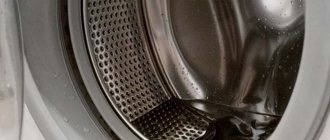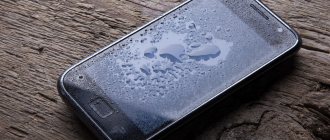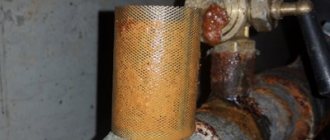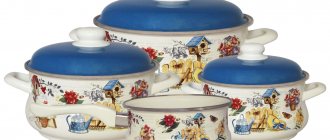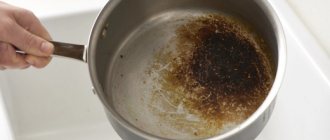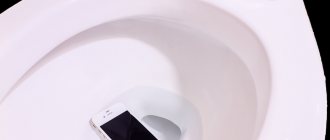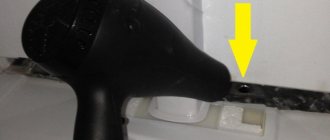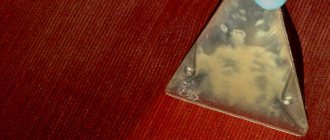Irons with a steam extraction function have the only drawback - they require the use of distilled water. Even filling the tank once with tap water can lead to scale or mold. If this happens, for cleaning the iron from the greens in the tank at home.
If you are interested in an article on the topic - how to clean the iron from scale inside the Philips, read our next article.
How bleach works - a proven folk remedy
The presence of mold in a water tank is indicated by stains on the surface of the fabric of a characteristic brown, gray or green color. If this is the case, then you can try to get rid of it using bleach. The product has the ability to react with mold spores, cleaning and protecting the surface from further formations.
It should be noted that the use of bleach will only be effective at the initial stage of infection, before the neoplasm spores penetrate deep into the surface of the tank. Bleach is an aggressive substance with a specific odor, so in no case should you ignore the stage of finishing the tank with clean water (you cannot use ammonia due to the formation of toxic gases).
Before cleaning the water container in the iron from mold, open the windows and vents in the room and protect your hands with gloves.
To prepare the solution, bleach is mixed with water in a ratio of 1:10. The resulting product is poured into the tank and left for a while, after which the steam function is turned on and the mold particles are released along with the solution through the holes. The final stage is rinsing the tank with distilled water.
Lemon acid
Citric acid is one of the most popular anti-scale agents.
There are several ways to clean a steam generator.
Method 1
- Dilute 1 tbsp. l. acid in 1 liter of water.
- Pour the resulting liquid into the reservoir.
- After 20 minutes, switch the device to maximum steam mode and leave it until the liquid has completely evaporated.
- Rinse the device well.
- Pour in clean water and evaporate it.
Method 2
In particularly advanced cases, you should disassemble the steam heater and clean it manually from the inside. It is recommended to use this method at least once every 2 years.
The action plan is:
- Disassemble the device with a screwdriver. This must be done carefully, preferably according to the instructions.
- Wipe off the dust with a dry cloth.
- 1 tsp. dissolve citric acid in 1 tbsp. hot boiled water.
- Seal all holes in the work surface with tape.
- Pour the solution into the boiler. An active reaction will begin and foam will flow out of the holes. It is important to ensure that it does not get on the wires and contacts, and to wipe off any excess with a sponge.
- Leave the liquid in the steam generator for half an hour.
- Drain the solution along with the removed lime.
- Rinse equipment with warm water.
- You can clean small holes and hard-to-reach places with a thin brush dipped in lemon juice solution.
- Assemble the steam generator, remove the remaining tape and iron a test waste cloth.
Instead of lemon juice, you can use any other descaling agent: Antiscale, vinegar or soap.
Important! Keep in mind that the fumes from vinegar and citric acid smell sharp and unpleasant. Therefore, during the procedure, it is recommended to open the window and turn on the hood.
This method is suitable for cleaning the soleplate of the steam generator:
- Dissolve a little soap in water.
- Apply the resulting liquid onto a soft sponge.
- Wipe the surface to be descaled with it.
- Rinse with water.
The same can be repeated using dishwashing detergent.
How to get rid of mold using borax
To clean the iron from algae - the result of stagnant tap water, borax is suitable. The completely natural product does not contain chemicals, does not emit toxins, is suitable for cleaning drains and toilets, and can be used as an insecticidal agent in the fight against mold.
To remove mold from the iron reservoir you need to:
- mix borax with water (a glass of the product per 2.5 liters of water);
- prepare a stiff brush;
- Fill the reservoir with solution and clean it with a brush;
- Rinse off any remaining product with clean distilled water.
One rinse will be enough to remove excess solution. Residues of the product on the surface of the tank must be left, they can prevent the growth of bacteria.
Prevention measures
In order for the steam generator to last as long as possible and be less susceptible to scale formation, it is recommended to follow a number of simple rules. For example, only filtered or melted water should be poured into the tank. Tap water contains a large amount of salts and impurities, so it is prohibited to use it unfiltered. Boiled water is also not suitable for steam cleaners, as it forms sediment during the boiling process. As for distilled water, it has too high a vaporization temperature, so it is far from the best option. Spring water contains a large amount of minerals and salts, which quickly turn into scale, and a special flavored liquid often leaves stains on clothes.
If you use the device regularly, it should be cleaned at least 2 times a month, and after each use, be sure to drain the remaining water from the reservoir. It is not recommended to clean the steam cleaner using hard sponges and abrasive substances, as well as products containing hydrochloric acid.
If you do not plan to use the steam cleaner for some time, then it should be washed, wiped dry with a clean cloth, put in a box and stored at room temperature away from heating devices.
See below for the steam generator cleaning method.
Vinegar against mold - how effective is it?
When water blooms in the iron, vinegar essence can also help. Both pure and diluted, vinegar can get rid of 80% of bacterial species. Natural distilled vinegar is suitable for processing. The advantages of the product include:
- efficiency;
- naturalness;
- affordable price;
- ease of use.
The cleaning process is not difficult. Vinegar, concentrated or diluted, is poured into a water container and left for an hour or two, depending on the degree of contamination. After this time, turn on the steam function, releasing the solution along with the remaining mold. After treatment, the tank is rinsed again with clean water.
Mold and ammonia - how they interact
Just like the bleach described above, ammonia helps remove mold on surfaces. Being a chemical substance, after treatment, alcohol is washed off with distilled water, without adding bleach under any circumstances.
You can achieve the effect by mixing alcohol with water and filling the iron reservoir with it for several hours. The steam removal function will allow you to get rid of the solution. With its help, you can additionally clean the holes on the sole.
If fabric is stuck to the Teflon or other coating
If a piece of synthetic fabric is stuck to the soleplate of the device, heat the iron as high as possible and wait until the fibers melt. Then remove them using a wooden spatula and iron a terry cloth (for example, an old towel).
If, after removing the remaining fabric, marks remain on the sole, they can be removed using a “mush” of dishwashing liquid and soda. Apply it to a cloth and wipe the cooled surface with it. Remove the remaining mixture with a damp swab, then wipe the sole with a dry cloth.
To remove old dirty deposits, soak a piece of medical bandage folded several times with ammonia and iron it with a hot iron.
Burnt fabric from aluminum and steel soles can also be removed using a regular wooden spatula or plastic brush. Simply heat the iron to about +70°C. Don't worry, the coating won't be damaged.
Tea tree oil is a safe method for removing mold
A non-standard option that allows you to get rid of mold in the iron tank is tea tree oil. Unlike all the remedies described above, oil is not cheap. A few drops are enough to remove mold. Antifungal and antibacterial, the oil is mixed with water (a teaspoon per glass of water) and added to the iron container. The final step is to remove the liquid through the steam holes.
Tap water is full of various impurities. They negatively affect the operation of steam generators and irons. Because of this, scale and rust form inside the device, which reduces the quality of ironing and damages the fabric. If the steam system is rarely used, the water tank may become moldy and green on the inside. It is important to know how to clean an iron from mold, rust and scale in order to extend its working life and avoid damage to fabrics.
Features of internal cleaning
If the iron spits rust, this may be due to the deterioration of the internal elements of the silicone steam generator. These parts are gaskets between the water tank and the base of the device.
- During prolonged use, the sole becomes hot. At the right time, the thermostat, which turns off the iron to prevent excessive overheating, does not work.
- The metal heats up to such an extent that it begins to affect the insulation of the silicone steam generator chamber.
- At a heating surface temperature of about 300 degrees, even heat-resistant silicone material melts.
- The iron begins to spit out brownish liquid. This is not rust, but molten silicone, similar in color to it.
It is necessary to replace a thermostat that has stopped working. The new unit will allow you to get rid of excessive overheating of the metal elements of the iron. If this is not done, the device may become unusable.
Real rust occurs not only due to poor quality water, but also due to a violation of the insulation of metal elements from moisture inside the steam generator chamber. If they are corroded, there is no point in repairing the device. If it’s just a matter of rusty or moldy stains due to bad water, the iron can be used quite well after proper cleaning.
Why is scale dangerous?
Scale is made up of salts, calcium and magnesium. They remain in the steam heater after the water has evaporated and form lime. Limescale can seriously damage an item: it can remain on the fabric in the form of yellow stains or white flakes.
Plaque also conducts heat poorly and does not absorb it. This means that the device will heat up for a long time, spending a lot of energy, and over time it will stop working completely.
Therefore, it is so important to clean the steam heater from it in a timely manner.
Steam generators of new models have a self-shut-off function; it is triggered when there is too much scale in the device. This technique “can” self-clean, that is, to remove scale, it is enough to turn on the cleansing mode and steam a piece of unnecessary fabric. If there is no such function, an unpleasant odor and weak steam pressure indicate the need to clean the steam generator. To achieve the best results, you should clean both the inside (water tank) and the outside (sole) of the device.
Cleaning accessories
Some models have a special self-cleaning system. For this purpose there is a special button located on the body of the device. According to the manual, heat the device to the required temperature. To start the cleaning process, press the button.
With such a system, any housewife will be able to clean the device without effort.
If rust and scale are not washed out of the iron, it is disassembled and all parts are washed manually. If you do not completely trust your knowledge of technology, it is better to entrust this activity to a professional.
Household chemicals
If brownish or whitish stains appear on the sole, which differ from ordinary burnt marks, you can use Anti-scale. The process is simple. Following the instructions, dilute the product in water, then pour it into a container and heat the iron strongly. Turn it off and wait about 30 minutes. Drain the contaminated liquid and clean the container with clean water.
German-made compounds containing organic acids and anti-rust components also help: Topperr, Bosch, Filtero 605.
To clean the iron from rust inside with such preparations, follow this procedure:
- Dissolve the product in water in a ratio of 3:1.
- Preheat the iron by setting the control to maximum, and then turn it off.
- Pour the composition into the water inlet, place the device horizontally and wait 2 hours.
- Pour out the product and rinse the inside a couple of times with water.
Immediately before ironing, check the cleanliness of the appliance by releasing steam.
The drug “Silit” perfectly removes corrosion and scale. To clean the iron, you need to turn it upside down and carefully pour the cleaning agent drop by drop into the sole holes. After a few minutes, traces of rust will appear on the outside. Remove them with a dry cloth, then add water, and press the steam release buttons several times.
Folk remedies
You can also clean your ironing device from traces of corrosion, lime and fungus using traditional methods. Mold marks will go away if you use recipes against rust and scale, but to remove mold forever, it is better to choose specific products.
Recipes against rust and scale
If the device spits out rusty liquid, or white scale stains remain on the fabric, compounds with high acidity are used. Usually vinegar or citric acid is used, but you can also use sparkling water.
Anti-corrosion care for irons
Like any household appliance, the iron requires protection against internal contamination. Then its service life will increase, and the laundry will not become dirty when ironing.
Follow these recommendations:
- do not iron synthetics at maximum temperature;
- monitor the quality of the water used;
- Always drain the container after ironing.
Do not use only distilled water for ironing. Its boiling point is higher, vaporization is worse, which can cause damage to the internal walls of the device. It is better to choose boiled. Hard water is mixed with distilled water in equal parts.
If rust marks appear on ironed laundry, it is worth disassembling the device. Perhaps the problem is the melting of silicone parts or corrosion of metal parts. In order not to aggravate the situation by cleaning, it is worth carrying out a preventive check and, if necessary, sending the iron for repair.
Irons with a steam extraction function have one drawback - they require the use of distilled water. Even filling the tank with tap water once can lead to the appearance of scale or mold. If this happens, then you can clean the iron from the greens in the tank at home in several ways.
The iron turns on, the light is on, but the soleplate does not heat up
Iron repairs are carried out only when the product is unplugged from the outlet.
In all other cases, repair and replacement of any part is allowed. It all depends on the experience and qualifications of the person.
What tools are needed for repairs?
The most necessary tool when repairing an iron is a set of screwdrivers - Phillips and flat. Experts also recommend keeping a wide, flat knife on hand to pry off parts with rivets. A multimeter is also indispensable for assessing the performance of parts and wires.
Additionally, take a soldering iron in case you have to solder loose contacts or replace some parts.
No more tools are required, however, during the work you will need electrical tape and sandpaper.
Expert opinion
It-Technology, Electrical power and electronics specialist
Ask questions to the “Specialist for modernization of energy generation systems”
8 ways to clean your iron from scale and carbon deposits without harming the coating Even if your iron has stopped steaming properly and instead started spitting flakes and dirtying your clothes, don’t rush to retire it. Ask, I'm in touch!
How bleach works - a proven folk remedy
The presence of mold in a water tank is indicated by stains on the surface of the fabric of a characteristic brown, gray or green color. If this is the case, then you can try to get rid of it using bleach. The product has the ability to react with mold spores, cleaning and protecting the surface from further formations.
It should be noted that the use of bleach will only be effective at the initial stage of infection, before the neoplasm spores penetrate deep into the surface of the tank. Bleach is an aggressive substance with a specific odor, so in no case should you ignore the stage of finishing the tank with clean water (you cannot use ammonia due to the formation of toxic gases).
Before cleaning the water container in the iron from mold, open the windows and vents in the room and protect your hands with gloves.
To prepare the solution, bleach is mixed with water in a ratio of 1:10. The resulting product is poured into the tank and left for a while, after which the steam function is turned on and the mold particles are released along with the solution through the holes. The final stage is rinsing the tank with distilled water.
We clean the steam generator from scale: citric acid, vinegar and other means to get rid of plaque
The steam generator is practically indispensable in the household. This multifunctional device saves time and effort and makes life easier. With its help, you can easily iron linen and clothes, clean carpets, curtains, tiles and much more.
To prevent scale, it is recommended to pour only distilled water into steam generators. But this is not always possible. Tap water contains a large amount of salts, which lead to the formation of limescale. It can greatly spoil the quality of the equipment or even disable it. Therefore, you need to get rid of accumulated lime and carry out cleaning from time to time for prevention. This article contains tips on how to clean a steam generator from lime deposits without resorting to the services of specialists.
How to get rid of mold using borax
To clean the iron from algae - the result of stagnant tap water, borax is suitable. The completely natural product does not contain chemicals, does not emit toxins, is suitable for cleaning drains and toilets, and can be used as an insecticidal agent in the fight against mold.
To remove mold from the iron reservoir you need to:
- mix borax with water (a glass of the product per 2.5 liters of water);
- prepare a stiff brush;
- Fill the reservoir with solution and clean it with a brush;
- Rinse off any remaining product with clean distilled water.
One rinse will be enough to remove excess solution. Residues of the product on the surface of the tank must be left, they can prevent the growth of bacteria.
Toothpaste
Toothpaste is a fairly effective, but at the same time delicate, iron cleaner. As in the case of salt, the simplest and most budget-friendly one without additives, dyes and flavors is better. You will need:
A drop of toothpaste.
What to do:
Just a little paste is all you need - you need to apply it in a thin layer over the soleplate of the iron. Rub the dirtiest areas a little separately and leave everything for 5-10 minutes until the paste eats away the burnt marks and plaque. Wipe the surface and iron the unnecessary rag a couple of times for final cleaning.
Vinegar against mold - how effective is it?
When water blooms in the iron, vinegar essence can also help. Both pure and diluted, vinegar can get rid of 80% of bacterial species. Natural distilled vinegar is suitable for processing. The advantages of the product include:
- efficiency;
- naturalness;
- affordable price;
- ease of use.
The cleaning process is not difficult. Vinegar, concentrated or diluted, is poured into a water container and left for an hour or two, depending on the degree of contamination. After this time, turn on the steam function, releasing the solution along with the remaining mold. After treatment, the tank is rinsed again with clean water.
What to do if your water tank blooms?
Housewives often encounter such a phenomenon as contamination of the water tank in the iron. You can make an effective solution from 30 g. citric acid and 500 ml of warm water. Fill the reservoir with liquid for 2-3 hours. After the time has passed, rinse the container with water. For further use, fill the tank with, preferably, distilled water.
Mold and ammonia - how they interact
Just like the bleach described above, ammonia helps remove mold on surfaces. Being a chemical substance, after treatment, alcohol is washed off with distilled water, without adding bleach under any circumstances.
You can achieve the effect by mixing alcohol with water and filling the iron reservoir with it for several hours. The steam removal function will allow you to get rid of the solution. With its help, you can additionally clean the holes on the sole.
Salt
If you have it, take sea salt - it absorbs any dirt faster. And at the same time it is an excellent natural antiseptic - it will also serve as disinfection. Just take salt without dyes, flavors or additives. You will need:
A thick sheet of paper and a spoon of salt.
What to do:
Drain all the water from the iron, turn off the steam and heat it at maximum power. Spread a spoonful of coarse salt in an even layer on an old pillowcase or thick paper sheet. Iron it back and forth several times and the burn will go away on its own. The main thing is not to press too hard so as not to scratch the surface of the sole on the salt crystals.
Hydrogen peroxide and soda - simple methods to combat mold
When you need to clean a container of water from mold, hydrogen peroxide will help remove green deposits from the bottom and walls, providing protection against new formations for the future. The antifungal agent works well against mold, is safe, and does not contain toxins.
Removing mold with peroxide is easy. To do this, pour it into a container for no more than 10 minutes, speed up the process with a narrow, hard brush.
A simple and safe remedy is baking soda. The product is safe, does not release toxins, has a gentle effect on the walls of the tank, delicately removing traces of mold. The advantage of this method is the ability of soda to absorb moisture, which prevents the formation of bacteria in the future. To clean, mix soda with water at the rate of ¼ tablespoon per glass of distilled water.
Cleaning durable surfaces
The soles made of titanium, stainless steel, and metal with sapphire coating are very durable, so abrasive substances can also be used when cleaning.
Salt
Salt is not harmful to hard surfaces; it acts as a kind of scrub. The salt poured onto a white paper sheet is “ironed” for a minute. It will darken and the sole will become clean. Melted synthetic material from a strong surface can be scraped off with a wooden spatula.
Matchbox
Or rather, not the whole box, but only sulfur applied to the side. Use this area to gently rub the dirt on the sole.
Paraffin
Before use, place a slightly heated iron in a tray so that the wax applied to the sole and melted by the temperature flows into the container and not onto things. You can remove any remaining paraffin by ironing the unwanted fabric.
Dishwashing liquid
Take baking soda, dilute it with liquid, and apply the resulting slurry to a cold sole. Leave for 10 minutes, rub the surface, then remove the mass with a damp cloth.
Important:
Even such surfaces should not be cleaned with sharp objects, sandpaper or a knife should be used. Scratches on the soleplate may impair the performance of the device.
